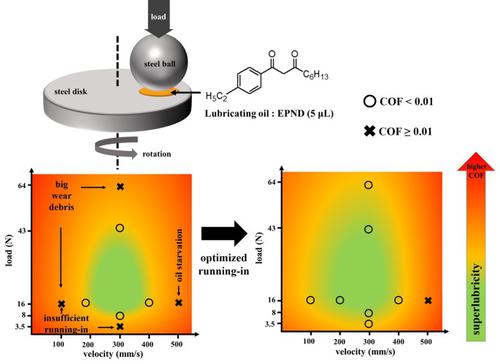Friction ( IF 6.8 ) Pub Date : 2023-01-06 , DOI: 10.1007/s40544-022-0647-0 Yuyang Yuan, Tobias Amann, Yuwen Xu, Yan Zhang, Jingfu Chen, Chenqing Yuan, Ke Li

|
The clarification of the critical operating conditions and the failure mechanism of superlubricity systems is of great significance for seeking appropriate applications in industry. In this work, the superlubricity region of 1,3-diketone oil EPND (1-(4-ethyl phenyl) nonane-1,3-dione) on steel surfaces was identified by performing a series of ball-on-disk rotation friction tests under various normal loads (3.5–64 N) and sliding velocities (100–600 mm/s). The result shows that beyond certain loads or velocities superlubricity failed to be reached due to the following negative effects: (1) Under low load (≤ 3.5 N), insufficient running-in could not ensure good asperity level conformity between the upper and lower surfaces; (2) the high load (≥ 64 N) produced excessive wear and big debris; (3) at low velocity (≤ 100 mm/s), the weak hydrodynamic effect and the generated debris deteriorated the lubrication performance; (4) at high velocity (≥ 500 mm/s), oil migration occurred and resulted in oil starvation. In order to expand the load and velocity boundaries of the superlubricity region, an optimized running-in method was proposed to avoid the above negative effects. By initially operating a running-in process under a suitable combination of load and velocity (e.g. 16 N and 300 mm/s) and then switching to the target certain higher or lower load/velocity (e.g. 100 N), the superlubricity region could break through its original boundaries. The result of this work suggests that oil-based superlubricity of 1,3-diketone is a promising solution to friction reduction under suitable operating conditions especially using a well-designed running-in strategy.
中文翻译:

使用 1,3-二酮的油基超润滑的载荷和速度边界
阐明超润滑系统的临界运行条件和失效机理对于在工业上寻求合适的应用具有重要意义。在这项工作中,1,3-二酮油 EPND(1-(4-乙基苯基)壬烷-1,3-二酮)在钢表面上的超润滑区域通过执行一系列球盘旋转摩擦试验确定在各种法向载荷 (3.5–64 N) 和滑动速度 (100–600 mm/s) 下。结果表明,超过一定的载荷或速度,由于以下负面影响,未能达到超润滑:(1)在低载荷(≤3.5 N)下,不充分的磨合不能保证上下表面之间良好的粗糙度一致性; (2) 高负荷(≥64 N)产生过度磨损和大碎屑;(3) 低速 (≤ 100 mm/s),微弱的流体动力作用和产生的碎屑使润滑性能恶化;(4) 在高速(≥500 mm/s)下,发生油运移,导致缺油。为了扩大超润滑区域的载荷和速度边界,提出了一种优化的磨合方法来避免上述负面影响。通过最初在负载和速度的合适组合(例如 16 N 和 300 mm/s)下运行磨合过程,然后切换到目标特定更高或更低的负载/速度(例如 100 N),超润滑区域可能会破裂通过其原始边界。这项工作的结果表明,1,3-二酮的油基超润滑性是在合适的操作条件下特别是使用精心设计的磨合策略时减少摩擦的有前途的解决方案。

























 京公网安备 11010802027423号
京公网安备 11010802027423号